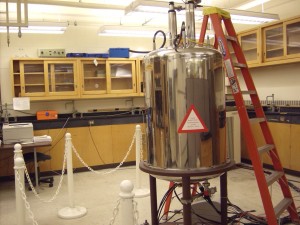C&EN published a report on the upcoming, potential shortage of helium. The US supply shutdown was postponed to 2021. As we approach this date, the helium prices may continue to be raised to unsustainable prices for academic labs.
Author: Tanya
IUPAC recommendations for chemical shift reference
Chemical shift reference
The standard for referencing chemical shifts is TMS 0 ppm (1H). The 2008 paper by Zilm describes the simple method for calculating the chemical shift of any other nuclei (13C, 31P, 29Si, etc.) without the use of an internal or external standard. IUPAC recommends this method over typical methods using secondary standards. Authors should note their method of referencing in all publications.
doi:10.1016/j.ssnmr.2008.02.004
Summary: https://www.chem.wisc.edu/~cic/nmr/Guides/Other/Xi_chem_shift_scale.pdf
DRX 500 MHz Retirement
The DRX 500 has been retired. The magnet has had an ice blockage issue for more than a year, increased costs for maintenance, and low usage. The 600 MHz was purchased to replace this system. So, yesterday evening the magnet was de-energized. A new start-up company based in Colorado, PhoenixNMR, will pack up the magnet in the next few weeks and ship it to their location. They will use the magnet to test their specialized probes.
All users’ NMR data are still available on the local PC as well as the NMR-Nutmeg network drive. If you stored your data on the Windows XP, please take time to backup this data to another location. This is an older computer and may have issues in the future.
AVIII 400 – SampleJet errors
The AVIII 400 is experiencing a hardware issue on the SampleJet. Your samples are occasionally getting stuck in the system, which stops the runs. If this issue continues to repeat at its current rate, we will be forced to shut the system down. The sample shuttle (a fancy version of the spinner) is getting lodged in the BST (the top of the magnet). There is a possibility of sample breakage, so we cannot continue to use the system.![20150316_141635[1]](https://u.osu.edu/cbcnmr/files/2015/03/20150316_1416351-1lknrmd-e1426532603338-169x300.jpg)
Bruker – Zurich is working on figuring out what the issue might be. The SampleJet keeps detailed logs of each sample insertion, including lift parameters and even a picture of each sample. Since its probably nighttime in Europe, we’ll likely not hear back until tomorrow.
Thanks for your patience as we work through the issue.
Tanya
UPDATE: This situation has been resolved by supplying more compressed air pressure to the system.
600 MHz NMR + Gyrotron
Everyone is asking about the newest instrument being installing in the CBEC NMR facility. This new instrument is a 600 MHz wide-bore NMR with a gyrotron magnet (the one that looks like a flying saucer) for Dynamic Nuclear Polarization. Rather than write about this state-of-the-art technique now available here at Ohio State, I will send you to the leader in the development of DNP-NMR. Here is an interview with Bob Griffin, MIT, who summarizes how they took an old trick and through yrs of patience came up with a commercially and scientifically viable ‘new’ spectroscopic technique.
The application of this system will be bio-solids and materials.
New CBEC NMR Facility Update
 The CBEC NMR lab is in another phase of installations after a break during the holidays. This week, on Tuesday, the AVIII 400 and DSX 300 were physically moved from Evans to CBEC. The 400 MHz is already cold (at helium temperature) and waiting for a service engineer to re-energize the magnet, assemble and spec the console, and re-install the SampleJet. My hope is these will be completed next week (Tues – Fri). Tentatively, the 400 will be available Monday, Feb. 23 or a few days after. The 300 MHz solid-state NMR is on a turbo pump through the weekend and will be cooled to helium temps next week.
The CBEC NMR lab is in another phase of installations after a break during the holidays. This week, on Tuesday, the AVIII 400 and DSX 300 were physically moved from Evans to CBEC. The 400 MHz is already cold (at helium temperature) and waiting for a service engineer to re-energize the magnet, assemble and spec the console, and re-install the SampleJet. My hope is these will be completed next week (Tues – Fri). Tentatively, the 400 will be available Monday, Feb. 23 or a few days after. The 300 MHz solid-state NMR is on a turbo pump through the weekend and will be cooled to helium temps next week.
The next systems to be installed between now and April are the following:
600 wide-bore solid-state NMR with DNP option
500 wide-bore solid-state NMR (Chris Jaroniec’s research instrument)
800 wide-bore solid-state NMR
and 850 MHz solution NMR (Rafael Bruschweiler’s research instrument)


![20150303_153114[1]](https://u.osu.edu/cbcnmr/files/2015/03/20150303_1531141-xt0usy-300x169.jpg)